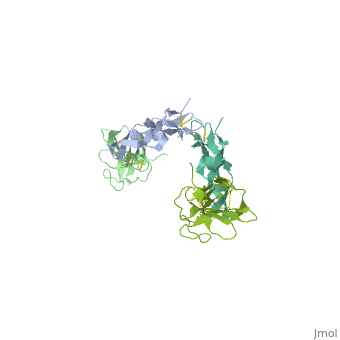TGF beta signaling pathway: Difference between revisions
Jump to navigation
Jump to search
No edit summary |
No edit summary |
||
| Line 1: | Line 1: | ||
<StructureSection load='1ktz' size='340' side='right' caption='Human hTGFR-II extracellular domain (green) complex with TGF-β3 (grey) (PDB code [[1ktz]])' scene=''> | <StructureSection load='1ktz' size='340' side='right' caption='Human hTGFR-II extracellular domain (green) complex with TGF-β3 (grey) (PDB code [[1ktz]])' scene=''> | ||
==The TGF beta superfamily of ligands== | |||
===Bone morphogenetic protein=== | |||
[[Bone morphogenetic protein]] | |||
BMP-7 see [[Student Projects for UMass Chemistry 423 Spring 2012-4]]. | |||
==[[TGF-beta receptor]]== | ==[[TGF-beta receptor]]== | ||
'''TGF-β receptors''' (Transforming Growth Factor) (TGFR) are serine/threonine kinase receptors. They are involved in paracrine signaling and are found in many types of tissue. TGF-β ligands include bone morphogenetic proteins, growth and initiation factors, anti-Mullerian hormone, activin, nodal TGF-β<ref>PMID:9525694</ref>. There are 3 types of TGFR: <br /> | '''TGF-β receptors''' (Transforming Growth Factor) (TGFR) are serine/threonine kinase receptors. They are involved in paracrine signaling and are found in many types of tissue. TGF-β ligands include bone morphogenetic proteins, growth and initiation factors, anti-Mullerian hormone, activin, nodal TGF-β<ref>PMID:9525694</ref>. There are 3 types of TGFR: <br /> | ||
Revision as of 17:33, 16 February 2022
The TGF beta superfamily of ligandsBone morphogenetic proteinBMP-7 see Student Projects for UMass Chemistry 423 Spring 2012-4.
TGF-beta receptorTGF-β receptors (Transforming Growth Factor) (TGFR) are serine/threonine kinase receptors. They are involved in paracrine signaling and are found in many types of tissue. TGF-β ligands include bone morphogenetic proteins, growth and initiation factors, anti-Mullerian hormone, activin, nodal TGF-β[1]. There are 3 types of TGFR:
|
| ||||||||||
